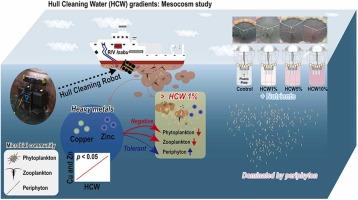船体清洗废水对沿海浮游生物群落的影响:一个中生态实验
IF 11.3
1区 环境科学与生态学
Q1 ENGINEERING, ENVIRONMENTAL
引用次数: 0
摘要
水内船体清洗被广泛用于处理船体上的生物污垢,它释放的废水(HCW)含有高浓度的重金属和悬浮固体。这些污染物可以直接改变水体化学和破坏浮游生物群落动态,但它们在沿海环境中的生态效应仍然知之甚少。本研究通过中生态实验,研究了增加HCW浓度(1%、5%和10%)对沿海海洋浮游生物生态系统(包括浮游植物、浮游动物和周围植物)的影响。暴露于≥5%的HCW会导致浮游植物丰度急剧下降(例如,从144 × 104细胞L - 1到2 × 104细胞L - 1),同时溶解铜(Cu)和锌(Zn)水平升高,而浮游动物丰度即使暴露于1%也会迅速下降。相反,周围生长的硅藻(如圆柱藻,Navicula spp)表现出相对的弹性,在后期,特别是在营养丰富的条件下,丰度增加到101 × 103细胞厘米毒血症。群落组成分析显示,在较高的HCW浓度下,微藻向耐金属、附着的微藻类群转变。基于性状的功能多样性分析表明,高HCW暴露降低了性状的分散度和冗余度,而排序分析表明,性状组成的变化与环境梯度有关。这些研究结果表明,HCW是一种复杂的生态应激源,可以改变浮游生物群落结构,降低功能容量,并强调将生态响应指标纳入未来机器人船体清洁排放管理策略的重要性。本文章由计算机程序翻译,如有差异,请以英文原文为准。

Effects of hull cleaning wastewater on coastal plankton community: a mesocosm experiment
In-water hull cleaning, widely used to manage biofouling on ship hulls, releases wastewater (HCW) that contains high levels of heavy metals and suspended solids. These contaminants can directly alter water chemistry and disrupt planktonic community dynamics, yet their ecological effects in coastal environments remain poorly understood. In this study, a mesocosm experiment was conducted to evaluate the effects of increasing HCW concentrations (1%, 5%, and 10%) on coastal marine planktonic ecosystems, including phytoplankton, zooplankton, and periphyton. Exposure to ≥ 5% HCW resulted in sharp declines in phytoplankton abundance (e.g., from 144 × 104 cells L⁻1 to 2 × 104 cells L⁻¹), coinciding with elevated dissolved copper (Cu) and zinc (Zn) levels, while zooplankton abundance declined rapidly even at 1% exposure. In contrast, periphytic diatoms (e.g., Cylindrotheca closterium, Navicula spp.) exhibited relative resilience, with abundances increasing up to 101 × 103 cells cm⁻2 during the later stages, particularly under nutrient-enriched conditions. Community composition analyses revealed a shift toward metal-tolerant, attached microalgal taxa at higher HCW concentrations. Trait-based functional diversity analyses indicated reduced trait dispersion and redundancy under high HCW exposure, while ordination analysis indicated that changes in trait composition were linked to environmental gradients. These findings demonstrate that HCW acts as a complex ecological stressor that alters plankton community structure and reduces functional capacity, and emphasize the importance of integrating ecological response indicators into future management strategies for robotic hull cleaning discharges.
求助全文
通过发布文献求助,成功后即可免费获取论文全文。
去求助
来源期刊

Journal of Hazardous Materials
工程技术-工程:环境
CiteScore
25.40
自引率
5.90%
发文量
3059
审稿时长
58 days
期刊介绍:
The Journal of Hazardous Materials serves as a global platform for promoting cutting-edge research in the field of Environmental Science and Engineering. Our publication features a wide range of articles, including full-length research papers, review articles, and perspectives, with the aim of enhancing our understanding of the dangers and risks associated with various materials concerning public health and the environment. It is important to note that the term "environmental contaminants" refers specifically to substances that pose hazardous effects through contamination, while excluding those that do not have such impacts on the environment or human health. Moreover, we emphasize the distinction between wastes and hazardous materials in order to provide further clarity on the scope of the journal. We have a keen interest in exploring specific compounds and microbial agents that have adverse effects on the environment.
 求助内容:
求助内容: 应助结果提醒方式:
应助结果提醒方式:


